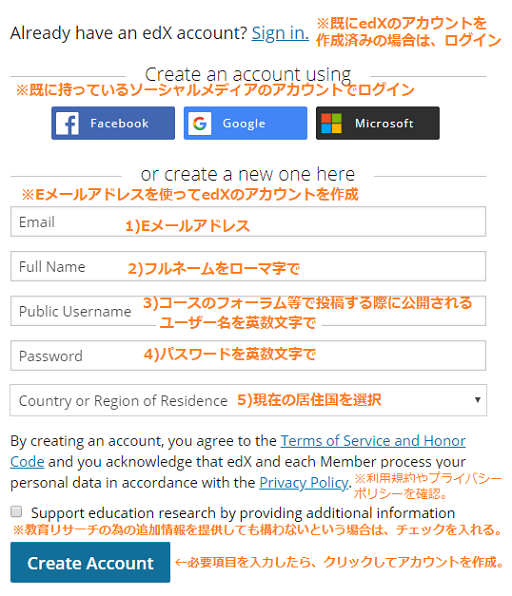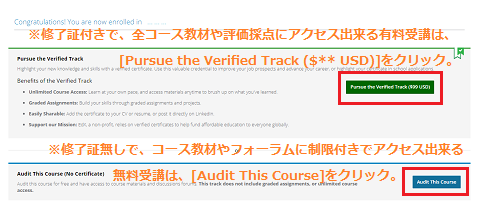日本の大学やニュージーランドのポリテクニック等で勉強及び資格取得をしたことがあり、留学生のサポートの仕事をしていた頃には、ニュージーランドのたくさんの小中高校を訪問したこともある英子ですが、最近のオンライン教育は、自分に合った学習方法で学ぶことが出来るという点で、かなり優れていると思います。ここ数年、インターネット上で誰もが無料で受講できる大規模で(Massive)開かれた(Open)オンライン(Online)講座、MOOC(ムーク/Massive Open Online Course)を利用して、新しい知識や資格を得ることが増えた英子です。
複数の大学や教育機関のMOOCをまとめて提供しているプラットフォームはたくさんありますが、英子が一番多く使っているのが、マサチューセッツ工科大学とハーバード大学によって2012年に創立されたedX(エデックス)。コンピューターサイエンスやプログラミング、心理学やワイン、ビジネス英語やジャーナリズム、データサイエンスにAIチャットボット等など、いろんなコースを無料又は有料にて受講しました。英語「を」学ぶのではなく、英語「で」何かを学ぶこと、英語「で」新しい知識を得ることの楽しさや、日本語だけの世界を超えた可能性の広がりを、みなさんにも知っていただきたくて、英子が使い慣れているedXで提供されている講義を下手英でご紹介することにしました。
やる気とインターネットに接続出来る環境があれば、誰でも受講出来ます。友人知人にいくつかのコースを紹介してみたものの、みんな、「げっ、全部英語っ」と、始める前に脳に拒絶反応が、、、。でも、自分の好きな時間に、好きな環境で、自分のペースで進めることが出来るオンライン講座。英語学習で成果が出なくて悩んでいる人こそ、アメリカのハーバード大学やイギリスのオックスフォード大学、日本の東京大学や京都大学の講義を、勇気を出して英語で受けてみませんか?
興味のある分野の「キーワード」や学んでみたい「大学・教育機関」選択リストへ戻る。
教育機関名: ()
修了証付き受講料: US$358.20
コース解説:英子の日本語による解説を、現在執筆中です。ご紹介したいコースがたくさんあり過ぎて、どのコースから書けばいいのか決められなくて困っています。リクエストが多いコースから、解説を追加していきたいと思いますので、このコースに興味があるという方、「早く解説を書いて~」と、英子までご連絡下さいませ。連絡は、あまりに多いスパムメールに涙している為、、、ツイッター@hetaei(スパムではないフォーロー、お待ちしています。。。願)経由、下手英ブログや英五感ブログへのコメントでお待ちしております。
コース概要: 
Setting a clear vision is essential for leaders in any organization, as it helps to guide decision-making and inspires employees and stakeholders to work towards common goals. Strategic planning leaders struggle with envisioning the future and may not have the skills to effectively communicate their vision. Senior leadership must then create action plans that elevate the strategic planning document so that all stakeholders are aligned. Strategy development matters only as much as it can be successfully executed. If you are considering a strategic planning process, you must be conscious of the interface between vision and execution.
The business environment is changing quickly as new technologies, risks and opportunities present themselves. Companies without strategic foresight and long-term vision capabilities will remain in reactive modes. Strategy formulation is not enough to withstand shocks. Strategists must commit time for reflective thinking and away from the day to day in order to scan the external environment and discover what the convergence of trends, demographics threats, and opportunities means for successful strategic planning.
Research shows that less than 10% of leaders consider themselves to be visionary and few think long-term about all stakeholders and their needs. This is a problem, as employees, product management teams, project managers and other stakeholders want to be part of a company with bold, clear strategic goals and strategic objectives that are ignited by a clearly described future state. The “why movement” linked to crafting purpose and organization’s mission statements is now being supplanted by the emerging “where movement.” This movement goes beyond brainstorming towards declaring the “big ideas” tied to long term goals that will inspire stakeholders and create a competitive advantage. “Where are we going?” as an organization is the primal question posed by employees that CEOs and product managers must smartly address. This program will show you how.
Furthermore, the rise of ESG (Environmental, Social, and Governance) investors and stakeholders has increased the pressure on companies to take a longer-term view and link their vision to sustainable measures that delight a broad set of stakeholders.
As leaders pivot from the vision towards strategy execution, they are then met with either resistance or lift as organizational architecture and economics bring realism against the aspiration. Operational plans must confront and align their 4 pillars that will enable leaders to execute the organizations goals or wind up frustrated by the inertia that they create. The 4-pillar methodology delivers a strategic framework that makes the linkage between:
One example of a leader who successfully applied this strategic framework is CEO Satya Nadella of Microsoft. By focusing on these four pillars, he was able to transform the organization’s mission and pursue new opportunities that led Microsoft to become one of the most valuable companies in the world. Too often leaders simply change an element of culture or a piece of performance evaluation and there is a breakdown as they must look at all four pillars simultaneously. Nadella reset Microsoft’s business model and strategy as he optimized the four pillars against a strategy map that helped all employees know what mattered the most. Once in place, Microsoft began to unleash an effective product strategy chasing new time frames that routinely encourages product plans that are bold with outstanding user experiences.
The program will also dissect cases like Wells Fargo where the business strategy and 4 pillars were misaligned and drove young employees to promote opening accounts with disastrous results for consumers and shareholders.
This two-part course will make the connection between a long-term vision and strategic planning driven by the CEO and C-suite and the translation down to product design teams and project managers who live in day-to-day execution. By reinforcing mechanisms that drive constructive behaviors, the course will help leaders turn their big ideas into practical, tangible products. In doing so, it will make the power of vision more accessible and help leaders to create value for all stakeholders. By focusing on long-term vision (and exploring cathedral and multi-generational thinking) and clearly communicating it through concrete language, imagery, initiatives and storytelling, CEOs and founders as well as the product managers can set their organization apart and unite their people towards a common, achievable future. This course will teach how your business plan and business goals can be elevated by vision (big ideas) and executed through the proper alignment and reinforcement mechanisms within the 4 pillars.
※下記、コースに申し込む手順を簡単に。(「もっと詳しい説明があった方がいいんじゃない?」と思われる方は、英子までお知らせ下さいませ。)
1. [詳細&申し込み]をクリックして表示されるリンク先ページで、「Enroll Now」(又は「Enroll」)をクリックします。Eメールによるお知らせ等を受信したい(受信しても構わない)という場合には、□I would like to receive email from [受講コースを開講している大学・教育機関]にチェックを入れます。
2. 既に登録済みのソーシャルメディアのアカウント(フェイスブック、グーグル又は、マイクロソフト)を使ってedXを利用する場合には、[Facebook]、[Google]又は、[Microsoft]をクリックします。Eメールアドレスを使って、edX用のユーザーアカウントを作成する場合には、or create a new one hereの下の登録フォームに必要事項を入力(英数文字で)し、[Create Account]をクリックします。※Terms of Service(利用規約)やHonor Code(カンニングや盗用など、不正なことはせず、ルールを守って受講するという約束事)を確認したり、必要に応じて、教育リサーチに協力する場合は、□にチェックを入れたりして下さい。
3. 通常、受講は、修了証付きで、全教材やフォーラム(他の受講者や、講師又はコースサポート担当者等と、質問や意見交換等が出来る)に制限なしでアクセス出来、評価採点も行われる有料受講(Verified Certificate(検証済み修了証)付き)と、修了書無しで、教材やフォーラムに制限付き(例:アクセス期間制限等)でアクセス出来る無料受講(Audit(査定)のみ)から選択出来ます。まれに、有料受講のみ受け付けている場合もあります。どんな内容か分からなくて、自分に合っているかどうか分からない場合は、無料受講で申し込んだ後、コース内容や教材を確認し、変更を受け付けている期間内(通常、数週間)に、有料受講に変更することが出来ます。
張り切って申し込んでみたのは良いけれど、いまひとつ使い方が分からないとか、ナビゲーションメニューの意味が分からないとか、勉強方法へのアドバイスが欲しいという方は、英子までお気軽にご連絡下さいませ。